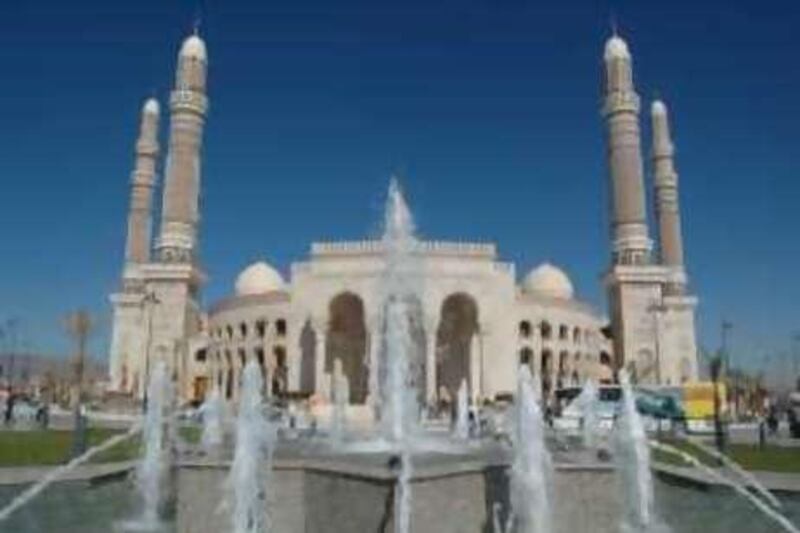SANA'A // There are hopes that a new mosque in Sana'a will help promote moderate Islam in the country in a bid to combat rising extremism, a leading cleric said. The mosque, built at a cost of US$60 million (Dh220m) and named after Ali Abdullah Saleh, the president, was opened on Friday along with an annexe for the Quran and Islamic Sciences College. During the first Friday prayers sermon after the official opening, Sheikh Alawi al Mashhoor said the role of the mosque and the college was to advance moderate Islam. "One of the tasks of the mosque and college is to tell the people that the history of Yemen is that of peace, tolerance, and we need to revisit these historical links so that the world knows how terrorism grew up and how it can be eradicated," Sheikh Mashhoor said. Several Islamic personalities took part in the inauguration ceremony, including Ekmeleddin Ihsanoglu, the secretary general of the Organisation of the Islamic Conference, and Sheikh Mohammed Sayyed Tantawi of the al Azhar mosque in Egypt. However, the high cost of the mosque, which took three years to build, has been criticised, with opponents saying the money could have been invested in health care or education. "The building is fabulous but we do not need it. We have plenty of mosques. We are short of electricity, of water, of hospitals and medicines. It is a vanity mosque," said Naser al Yazidi, a taxi driver. Ali al Jaradi, the editor of al Ahali weekly newspaper, said rulers in Islamic countries tend to immortalise themselves in the minds of the people by building such mosques. "Those who want to do a benevolent project, they do not name them after themselves. The mosque has become one of the landmarks of the city, but it should not turn into an achievement for the president as state media paints it. "It is an act of philanthropy where priority should have been building a hospital for cancer, which is a nagging problem in the country." The mosque covers about 27,300 sq m, accommodates 44,000 people and has a special chapel for women. It has six distinctive minarets, each 100 metres high, and features five domes. The minarets were built on specially designed bases about 35 meters deep to help them withstand damage from earthquakes, said Mohammed Abdullah Humaid, one of the architects who worked on the mosque. Mr Humaid said the mosque was meant to serve as an enduring symbol of both Islamic and Yemeni heritage so must be able to withstand the ravages of time. "Durability and resistance to extreme weather conditions were important factors for choosing building materials. The building's main structure is made of reinforced Yemeni concrete, which is famous for its enduring excellent quality," he said. Mr Saleh, the president, "instructed that the mosque's extensive stonework be carried out exclusively with local materials which stood the test of time," Mr Humaid said. He said a countrywide search for high-quality stone resulted in the discovery of new deposits of granite and marble, as well as black basalt, and black, white and red limestone. The basalt and limestone were used extensively in the mosque's construction. The white limestone was used only to cover the outer façades and the red and white speckled granite was used to cover the mosque's interior columns. The exteriors of the minarets were covered with red brick, a common feature of traditional Yemeni architecture. Stained glass, known as qamaria in Yemen, was also used extensively. Mohammed al Gharbi Emmran, a storyteller, said: "I was astonished by the extreme beauty of the mosque; the decorations, the Islamic carvings that adorn the ceiling and walls. "Inside the space subtly evokes almost every Islamic model." "The designer was successfully able to bring together various styles of traditional Yemeni architecture with some renovations; this creation has turned the mosque into a school from which many can learn the talents and skills of Islamic and Yemeni old and modern architecture. "It reminds me of famous Islamic mosques like Ummayyid mosque in Damascus, Sultan Qabos mosque in Oman. "But al Saleh remains a unique Yemeni characteristic that beautifies the whole country." mqadhi@thenational.ae
Mosque a move for moderate era of Islam
Critics say, however, the cost of construction of the new Sana'a landmark could have been better spent on hospitals or schools suffering from shortages.

Editor's picks
More from the national




